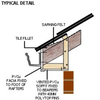I am looking to patch a water damaged soffit board, and wondering if anyone can tell me how this particular board is structured? I can see it is inserted into the wall on one side (rather it sits atop the wall) and fits into a groove at the back of the fascia board. It is not clear to me how the board is secured.
To fix it, I can cover it up with a new board of some kind and attach the new board by screwing it into the old board. The old board is water damaged and soft, and so the screws might not work. The other way of doing it is to cut out a section of the damaged board and put in place a new section. It's not clear how I can secure the new section. Help appreciated.

To fix it, I can cover it up with a new board of some kind and attach the new board by screwing it into the old board. The old board is water damaged and soft, and so the screws might not work. The other way of doing it is to cut out a section of the damaged board and put in place a new section. It's not clear how I can secure the new section. Help appreciated.


